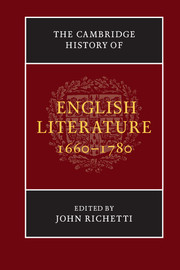Book contents
- Frontmatter
- Introduction
- PART I LITERARY PRODUCTION AND DISSEMINATION: CHANGING AUDIENCES AND EMERGING MEDIA
- PART II LITERARY GENRES: ADAPTATION AND REFORMATION
- PART III LITERATURE AND INTELLECTUAL LIFE: THE PRODUCTION AND TRANSMISSION OF CULTURE
- PART IV LITERATURE AND SOCIAL AND INSTITUTIONAL CHANGE
- PART V LITERARY GENRES: TRANSFORMATION AND NEW FORMS OF EXPRESSIVENESS
- 24 Personal letters
- 25 Diary and autobiography
- 26 The Gothic novel
- 27 Eighteenth-century travel literature
- 28 Women novelists 1740s–1780s
- 29 Burke and the uses of eloquence: political prose in the 1770s and 1780s
- PART VI CONCLUSION
- Chronology
- Bibliographies
- Index
- References
26 - The Gothic novel
from PART V - LITERARY GENRES: TRANSFORMATION AND NEW FORMS OF EXPRESSIVENESS
Published online by Cambridge University Press: 28 March 2008
- Frontmatter
- Introduction
- PART I LITERARY PRODUCTION AND DISSEMINATION: CHANGING AUDIENCES AND EMERGING MEDIA
- PART II LITERARY GENRES: ADAPTATION AND REFORMATION
- PART III LITERATURE AND INTELLECTUAL LIFE: THE PRODUCTION AND TRANSMISSION OF CULTURE
- PART IV LITERATURE AND SOCIAL AND INSTITUTIONAL CHANGE
- PART V LITERARY GENRES: TRANSFORMATION AND NEW FORMS OF EXPRESSIVENESS
- 24 Personal letters
- 25 Diary and autobiography
- 26 The Gothic novel
- 27 Eighteenth-century travel literature
- 28 Women novelists 1740s–1780s
- 29 Burke and the uses of eloquence: political prose in the 1770s and 1780s
- PART VI CONCLUSION
- Chronology
- Bibliographies
- Index
- References
Summary
Like literature itself, literary criticism has its fashions – its fads and caprices and strange gleamings – all of which can shed an instructive light on intellectual history and indeed life itself. Surely no literary-historical phenomenon has undergone a more sweeping critical re-evaluation over the past one hundred years than the late eighteenth-century vogue for the ‘Gothic’ – that exorbitant hankering after horror, gloom and supernatural grotesquerie so palpable in Britain in the literature and art of the 1790s especially. Long disparaged as one of the more regrettable, even absurd episodes in English literary history, the so-called ‘Gothic Revival’ of the later eighteenth century has in recent decades come to be seen as one of the signal aesthetic manifestations of the age – as a phenomenon both fascinating in its own right and crucial to a proper understanding of eighteenth-century art and culture more generally
Literary critics of the early decades of the twentieth century, contriving to establish the moral and intellectual gravity of their enterprise, had little patience with Gothic whimsy and extravagance. The Gothic craze has always been easy to satirize, of course: Jane Austen's delightfully irreverent Northanger Abbey, composed in the mid 1790s, when the vogue for the emotionally supercharged ‘tale of terror’ was at its height, provided the pattern for a host of later comic spoofs and burlesques. Most early twentieth-century scholars, eager to enter the lists against vulgarity (past and present) and the excesses of popular taste, took the great novelist's cue more or less reflexively. If Gothic fiction was to be discussed at all, it was hardly something to be taken very seriously.
- Type
- Chapter
- Information
- The Cambridge History of English Literature, 1660–1780 , pp. 673 - 706Publisher: Cambridge University PressPrint publication year: 2005
References
- 4
- Cited by

